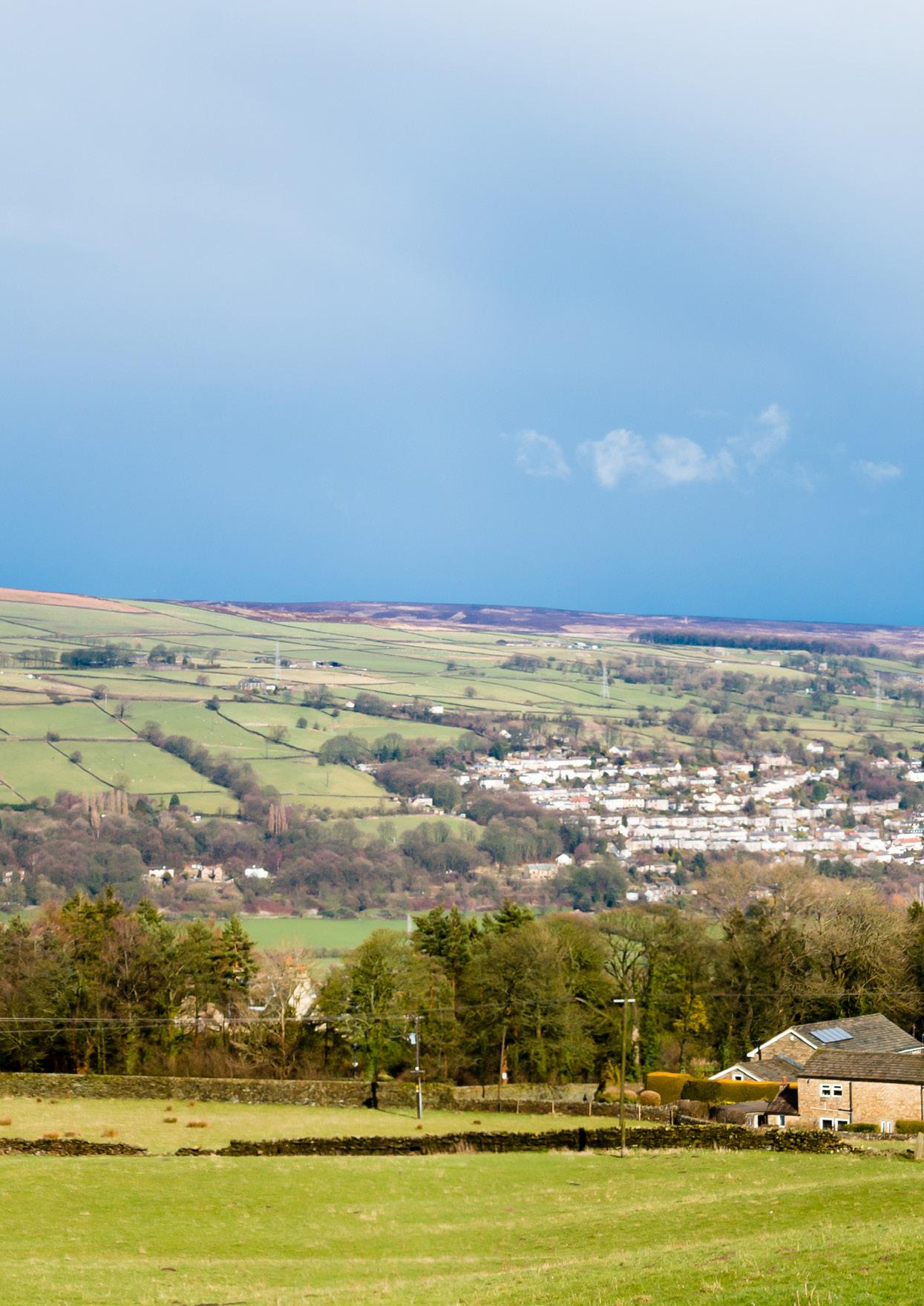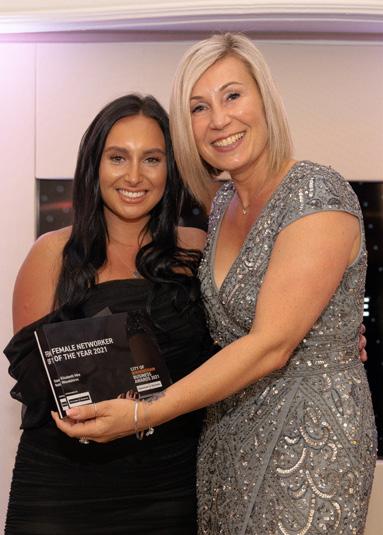
25 minute read
UK’S NET-ZERO GOAL RELIES ON R&D IN CONSTRUCTION
WORDS BY BEN VAAS
COMMERCIAL LEAD, AYMING UK
Advertisement
The UK aims to achieve net-zero carbon emissions by 2050, yet, at the same time has pledged to build more houses and invest heavily in infrastructure projects across the UK. Achieving both will only be possible if the construction sector finds ways to reduce its carbon footprint, which cannot be achieved without devoting time and resources to innovation.
There should be no illusions at the scale of the problem faced: building accounts for 40% of carbon emissions in the UK and 60% of all waste. According to the Committee on Climate Change, the industry has little more than 10 years to make all new buildings netzero to comply with climate targets.
Part of this problem stems from the construction sector being slower to innovate compared to other industries. This has been caused, not by a lack of willingness, but a lack of funding, as construction companies generally make less profit, which means they have often cannot spare the cash to pump into innovation projects.

BUILDING FOCUS ON R&D
However, it is dawning on construction firms that allocating capital for R&D is essential for progress and the sector is now taking strides as businesses begin to implement technology that has been talked about for a long time, whether that be robotics, digitalisation, or alternative materials. Part of this progress has come from construction borrowing from advances in other fields, but there has also been a wealth of construction-specific R&D, such as advances in material science and understanding of structures and failure modes.
A key aim for going forward must be to use these advances to design new buildings to be net-zero or, even better, energy-positive buildings that give back more than they consume over their lifetime by using battery storage and other smart solutions.
As well as the structure itself, companies must look toward the building process. Firms must act immediately to de-carbonise energy use on construction sites, where diesel power is still the dominant power source. Some major contractors are trialling hybrid generators but the technology is still small scale, which means R&D has to be ramped up.
Additionally, there is a huge scope for materials producers and contractors to utilise technology to tackle construction’s huge waste stream. Major firms such as AIUK and Hanson are already doing this, focusing on re-purposing raw materials. There isn’t just an environmental incentive but a business one. In Ayming’s
recent report into the state of global innovation, we found that the most popular answer for why businesses are undertaking sustainable innovation projects is because it will improve business performance.
Firms can also reap the rewards of data and analytics. The cost of IT infrastructure has come down to such an extent that firms can reap the benefits for minimal overheads. They can utilise this infrastructure to develop tracing and data to understand where the kinks in the supply chain lie. This is particularly valuable for concrete, for example, which accounts for 8% of humanity’s carbon footprint. The availability of technology to support innovation is vital and is seen as the most important factor that firms need to help them to not only successfully innovate but innovate sustainably, according to our recent IIB report.
Covid-19 might help achieve the netzero goal for construction.

Despite many worrying that Covid-19 would slow this progress down, it has increased innovation in the construction sector. Companies have seen innovation as a way to cut down costs and innovate in the face of uncertainty, which is encouraging. The sector has realised that they must change to survive. Firms must continue on this course, and don’t cut back on R&D.
The past few years have seen incredible progress, as a sector that was once seen as lacking any innovation at all, has progressed leaps and bounds in such a short space of time. This progress must be continued – the national commitment to net-zero will require the whole construction sector to prioritise sustainable innovation going forward, through Covid uncertainty and beyond.
SUBSCRIBE TO OUR YOUTUBE CHANNEL


The North-West of England is home to some of the most prestigious buildings in the entire United Kingdom. Some of these are cultural landmarks, while others are business complexes at the heart of local communities.
In the wake of the appalling decision to remove Liverpool’s UNESCO world Heritage status we believe it’s more important than ever to highlight the rich heritage the city has and the continued investment into the region. The Liverpool City region in particular has a wealth of heritage buildings from Edwardian and Victorian to Pre and Post-War years. Between their incredible detail, eye-catching decoration, and unique history with renowned tales from their past, all these buildings ensure that the region stands out. However, many of these buildings have been altered and changed over the years due to their changing usage requirements.
The complexity that the renovation and restoration of these buildings brings including Grade I and II listed limitations requires, not only attention to the detail and decoration of the building but also that any construction works are sympathetic to the building’s history and its quirks. Krol Corlett have and continue to play a major role in honouring, restoring, and developing the heritage of these buildings so that their impact continues to be felt for many years to come.
Each project provides several challenges specific to the area and location of the property, some of which are now embedded within other modern city centre buildings.
With a long-standing 50-year history, the team at Krol Corlett have perfected an empathetic approach to these buildings and working alongside the challenges that they bring. Over this 50-year tenure we have worked in several landmark building across Liverpool City region including the Municipal Building, Port of Liverpool Building, Cunard Building and St Georges Hall. More recently, Krol Corlett have completed the £1.5 million refurbishment of Fraser House in Lancashire. The brief was to transform this unused office building into an innovative IT and digital hub on behalf of Lancashire County Council. The project began in July 2020 and was completed ahead of schedule. This was despite challenges along the way, such as the necessary extensive preparation and sand blasting of the existing steel structure covered in lead paint and a fire rating change that delayed the process of installing all-new lighting. Despite this Krol Corlett were able to adapt and overcome, thus completing their tasks on-time regardless while also preserving the complex’s historical features, a vital requirement of this project.
Krol Corlett have completed other significant local projects in recent years. One of these is the extensive external restoration of Moor Lane Mills in Lancashire. This required
a total refurbishment that would transform the external façades and regain structural stability of the high-level maintenance platforms. A key element here was to protect the retained features that have made this recognisable Mill Building a favourite amongst locals for so long.
On a larger scale, Krol Corlett also successfully worked with the Liverpool World Museum. Now, this would need the development of the popular New Egyptian space for visitors to enjoy. But the construction firm also produced a fresh commercial kitchen as well as upgrading the café, retail, and teaching areas by converting the Richard Foster wing and utilising it for all to enjoy. As you can see, the company works with big names, meets its targets, exceeds expectations, and does all of this well within the budgets set out by task managers.
Furthermore, Krol Corlett have some very exciting projects in progress as we write this, Including a £2 million project on the Liverpool Hope University campus in Aigburth. This will see the refurbishment of two incredible Grade II* listed properties, those being the Hermitage and Cloisters buildings. Anyone who has studied at or visited Hope campus will recognise the rich history of buildings like these, and how important it is to maintain them while also upgrading with an eye on the future. Hence why Krol Corlett will ensure that Hope campus’ heritage continues.
Additionally, the construction firm are also working on a £4 million upgrading of the Walker Art Gallery and Midland Railway building just by St. George’s Hall. This will see the protection of the internal galleries while replacing the roof of the complex in a safe manner that also allows visitors to continue coming to and from the gallery. And then there is the £5m refurbishment of another Grade II listed building, that being the highly recognisable Islington Mill in Salford. The project is being collaboratively delivered alongside Islington Mills Arts Council, Arts Council England, National Lottery Heritage fund and Salford City Council and is due for completion Autumn 2022.
Krol Corlett are proud to be at the centre of these projects that respect the past and pave the way for the future with a combination of preserving history whilst renovating to ensure that new history can be written within these legendary NorthWest buildings. But if these buildings stand, they will always remind locals, visitors, and international tourists of their incredible legacies.


BROCK CARMICHAEL LEADING THE WAY WITH SUSTAINABLE DESIGN SOLUTIONS
Brock Carmichael Architects has been delivering value and business success for clients based on tried and trusted architectural principles since 1974. They are a RIBA chartered practice combining architecture, planning, urban design and interior design, with an award winning track record of education, residential, regeneration and leisure and hospitality building projects. The practice was born out of helping communities regenerate themselves and their housing. This has informed their business culture and how they view themselves within the construction sector; listening to and understanding others before they respond is their formula for a successful project.
They want to build relationships as well as buildings and believe construction is a social process and collaborative teamwork is essential to successful delivery.
Brock Carmichael strive to remain abreast of all developments of best practice in environmental design and are keen supporters of the growing movement towards low carbon, energy efficient and ecologically responsive development. Recently, the practice are making an extra push to actively research evolving environmental design guidance, and send representatives to seminars, training sessions and briefings to better develop skills and knowledge with the ever changing landscape surrounding climate change.
They understand that the delivery of a sustainable development or building will not necessarily deliver a sustainable solution. How the building operates, within its context and the implications for resource use associated with transport, water and waste management, for example, is vital. Brock Carmichael can assist clients to plan for regulatory requirements being placed on our industry, with recent revisions to Building Regulations and step changes towards Zero Carbon, and the need for us to find affordable solutions to these challenges. Brock Carmichael are acutely aware of increasing budgetary and environmental restrictions being placed on our affordable housing clients, and that our solutions need to be cost-effective yet sustainable, robust, manageable, maintainable and considered over the long-term if projects are to maintain viability.
Brock Carmichael are currently working on a number of sustainableled developments including the Foxwood and Sycamore sites; 161 homes in Warrington across two currently dis-used brownfield former school sites. The Warrington sites are both completely gas-free schemes that will be heated using ground source heat pumps (Energy Performance Certificate - A rating). These developments are the first for Incrementum and will provide the first 27% of 600 affordable homes urgently needed across the Warrington region. There will be a high level of landscape infrastructure and communal shared spaces over private spaces, and this is provided in a sequence of spaces from landscaped parking courts, the central plaza to more private activity shared garden spaces for apartments along the north and east boundaries.
This will create a distinctive, open plan, urban ‘Home Zone’ streetscape with high quality realm and a strong sense of place through the scheme. The development will also propose measures to protect existing valuable local ecology and wildlife. All dwellings will have PV 75kW peak systems and electric vehicle charge point infrastructure will also be provided under recent planning requirements.

RE-PURPOSING TOWNS AND CITIES IN PARTNERSHIP IS VITAL TO CREATING CONNECTED, INCLUSIVE COMMUNITIES
Muse continues to deliver its unique brand of placechanging re-purposed regeneration in partnership.
WORDS BY PHIL MAYALL
BOARD DIRECTOR, MUSE DEVELOPMENTS

It’s safe to say that it’s been a challenging time for everyone. As we move forward, taking positive steps out of lockdown, we’re now in a position where we can see the postCovid landscape.
While there are definitely going to be economic bumps in the road, it’s certainly not the dystopian world many had predicted. There are clear opportunities available to bring forward the right schemes that deliver direct benefits to communities, driving inward investment and prosperity, while creating opportunities for all… which is where re-purposing, or urban regeneration, comes into play.
Urban regeneration or town-centre re-purposing isn’t having a one size fits all approach to deliver shiny new buildings in the hope that ‘if we build it, they will come’. It’s about understanding an area’s specific needs and issues, strengths, heritage and aspirations. Then working with the existing grain of the area, creating the right infrastructure and mix of amenity to bring people of all social demographics back and thereby maximising the positive impact on the community.
At the turn of the 20th Century, town and city centres were thriving places full of commerce, people and life. As time moved on, they destabilised, depopulated and became driven by an expanding retail offer, making places indistinguishable from one another, creating a sustained period of flux. What’s clear from this, is that it’s people living, working, studying, shopping and playing in central conurbations will drive their renaissance.
As we know, the structural shift away from ‘faceless’ and generic retail has been accelerated by the pandemic. By taking a long-term, broad-based view of regeneration, rather than looking at it piecemeal, real long-lasting change can be brought forward. The key now and to make sure our towns and cities are robust and resilient enough to tackle future crises, is making sure we turn them into true 15-minute cities that provide everything needed for work, leisure, education, amenity and living in a safe, vibrant, sustainable and connected place. Retail will remain highly relevant. However, it needs to be just that – relevant.
Across the Muse business, we’re increasingly being asked to look holistically at alternative uses for shopping centres that either local authorities have acquired to gain control of their town centre, or by institutional owners struggling with the rise of vacant units and reducing rental income. Again, this has been exacerbated by the pandemic.
Vital to the success of any programme of regeneration is collaboration and partnership. There’s a once in a multigenerational opportunity to transform places for the better. Councils have the ability to take this wider view, but in any event, they’re entirely right in their approach, and now more than ever, public-sector intervention is crucial if our towns and cities are to thrive in adversity. What’s key here is courage. The public and private sectors, working together, must have the courage of their convictions to look forward and take calculated risks where necessary. Essentially what was right for our towns and cities immediately prior to the pandemic will likely be right for the long term. Success requires a pragmatic, joinedup approach from both sides.
As a business, we’re proud to be part of a strong parent company in Morgan Sindall Group PLC, which is the UK’s leading construction and regeneration group, with strong cash reserves and a robust business model focusing on self-help and organic growth.
This gives us the resources to work alongside local authorities across the North West and beyond to take that long-term view but deliver at pace to deliver the change that’s needed.
Couple this with our tenacious team of development surveyors, project managers and corporate support, means we’re uniquely placed to create sustainable and place-changing schemes that’ll stand the test of time.

THE WORLD MAY BE CHANGING, BUT THE FORMULA REMAINS THE SAME
With talk of levelling up and investment in the North, Richard Bayley a cities and development consultant from Atkins, shares his thoughts on why local communities should have a voice in building back better.
WORDS BY RICHARD BAYLEY
CONSULTANT, CITIES AND DEVELOPMENT, ATKINS
Recent events have caused many of us to reflect on where we are in societal terms, both individually and collectively. They have also been a catalyst for change, in many cases positive, including the advances made by the science and technology sectors.
What has been interesting is people’s views on where they live, how they work and what is important to them concerning their leisure or downtime. It has become apparent to many people that “places matter” more so than they may have done.
So how can we transform places into what society needs them to be in the future? Is it about a wholesale redesign and redevelopment or a transformational approach? Is it simply about ‘levelling up’ in whatever form that investment may take?
Arguably the answer is and should be much simpler. Every place has a uniqueness routed in history, its commerce, its geography and its people or communities. There is no ‘one size fits all’ approach, however, there is a formula that has existed for centuries which leads to the evolution of places, enabling them to function successfully in a future world. The centre piece of that formula is the people that live there. People matter because, quite simply, they are the heart, soul and driving forces of places.

Atkins and Faithful+Gould have been working with towns across the country, especially in the North of England, to help develop Town Deals and Levelling up submissions to Government. Many of these towns have a fantastic industrial and cultural heritage. But historically, they have not had the investment and focus that enables them to evolve and have lost their way a little over the last few decades as a consequence.
Our approach has been to focus on understanding what matters to the people that live and work in these towns. We have intentionally taken a ‘back to basics’ approach with the formula to explore how you can develop the following elements of what we describe as a ‘circular economy’ (see diagram opposite) to deliver a thriving town:
• ECONOMIC GROWTH: re-energising the ‘engines’ of towns through revolving investment funds that are intentionally designed to kick start the industrial and engineering sectors and, by so doing, underpinning the retail and residential redevelopment within the town centres. In essence, it is about applying a defibrillator to improve the ‘beating hearts’ of the towns to reduce unemployment and increase footfall; • TOWNS CENTRES AND INFRASTRUCTURE: projects to improve the connectivity and movement, including active travel to allow better access and to spread the economic benefits around the towns and into surrounding communities;

• EDUCATION AND SKILLS: projects to increase essential education and technical skill attainment levels and better equipping people to enable them to support the future growth of their towns and reduce unemployment and deprivation levels;
• HEALTH AND WELL-BEING: creating new ‘one stop’ centres located within the towns that enable people in the communities to access a range of physical and mental health services and improve life expectancy levels;
• COMMUNITY FACILITIES: an investment fund to provide grants for local charities and communities to improve facilities that support social activities so that people feel part of a diverse and thriving community and remain living there.

There was a ‘cross cutting’ assessment of how we could embed and sustain carbon reduction and create social value across all of those elements.
Most importantly, the formula required comprehensive community engagement (e.g. online surveys) and participation (e.g. focus groups), so we ensured we designed all of the elements to work for the places or towns concerned. What is clear is that we as an industry and as a society need to improve the way underrepresented groups, especially from the BAME community, are engaged.
In conclusion, yes, investment is important but what is crucial is the formula applied to channel that investment and enable places to evolve and function better in a changing world. Comprehensive community engagement and participation remains the most vital component, as the people that live in those places are the ones that will make them work. In years to come, history might reflect that the pandemic changed the world but the formula for changing our places should remain the same.

WORDS BY DAVE SEED
MANAGING DIRECTOR, QUBE RESIDENTIAL

NORTH WEST STILL BOOMING, AS STAMP DUTY HOLIDAY BEGINS TO TAPER OFF
Well, what a year we have had! From the start of the first lockdown in March 2020, we have felt like we have been living in some surreal movie scene. At first, working from home was a novelty for most of us, who were used to a busy working environment. But as time progressed, reality set in and most of us were itching to get back into the office and back to some level of normality.
We had to adapt the way we carried out our normal procedures in the property industry, but we kept on going – letting and selling properties throughout the lockdown. As soon as we were allowed back into the office and to carry out normal viewings and appointments, we seen a real increase in sales and lettings transactions. More recently though, the number of new buyer enquiries slowed in July as the government’s stamp duty holiday begins to taper off, according to the latest residential market survey released by RICS. Despite this the North West has continued to show extremely positive figures over the past 3 months, especially in Manchester and Liverpool.
New buyer enquiries shrank over the month, with a net balance of -9% of respondents seeing a fall, down from +10% in June, and ending a positive four-month streak for the UK housing market. As a result, the number agreed sales also reportedly took a dip, posting a net balance of -21% in July across the UK, with sales volumes slowing most notably in Yorkshire & the Humber, the East Midlands and East Anglia.
House price growth was again influenced by the lack of properties ready for sale, with a net balance of -46% of respondents reporting a fall in new listings (down further from the -35% reported in June). It is therefore unsurprising that +78% of respondents reported house prices rising, although this is slightly down from the +82% reported in the past two months.
At the regional level, growth in house prices was seen across the UK, with the North of England, Wales and East Anglia seeing especially strong growth. On the flip-side, London saw more moderate feedback, however the latest net balance of +45% is still up when compared with previous results. With regards to completed transactions, the average sales price in Manchester has been £252,816 which is in an increase of 13.8% in last 12 months. Liverpool’s average of £139,335 has had an increase of 14.5% in last 12 months. Both of the main northern cities have performed extremely well, given the circumstance of the recent pandemic. A net balance of +66% of respondents nationally predict that prices will continue to rise over the next twelve months, up on the +56% from June. Demand from tenants looking to rent new homes remained strong for the fifth quarter in a row, with a net balance of +52% reporting a rise – with all parts of the UK experiencing growth from budding renters. Manchester has been our strongest city for lettings, with unprecedented demand in the last 3 months. Every new build block we released onto the market has been fully let in record time.
With new instructions from landlords remaining in decline (slipping from -6% last month to -20% in July), rents are now expected to rise over the next three months – this according to a net balance of +50% of respondents. This is simply down to a supply and demand shortage. As the supply shortens, it is natural for the UK average rent prices to rise.
Several factors could also affect upcoming new instructions, as landlords will begin to assess their future plans. The new tax rates for landlords that is currently tapering in, has seen some investors consider selling their portfolios, due to reduced net income. And the recent pandemic has also worried some landlords, after seeing some tenants struggle to pay their rents due to being on furlough or losing their jobs.
On a positive note, the property market in general remains buoyant and housing demand is currently 22% higher than a year ago. I always tell investors ‘you will never lose on property, as long as you hold onto it long enough’. There will always be peaks and troughs with any investment but investing in property will always prove one of the smartest moves you will ever make.


CELEBRATING THE BEST OF BIRMINGHAM BUSINESS
WORDS BY CRAIG MOORE
DIRECTOR, CJM ASSOCIATES

It was a privilege for my company, CJM Accountants to be approached to be the headline sponsor for the City of Birmingham Business Awards, particularly with it being such a high-profile and well regarded event throughout the city. From the off, Downtown In Business, were professional and accommodating in ensuring that CJM had the most positive and beneficial experience. The organisation of the event was deeply impressive, especially considering the uncertainty around the Covid restrictions, despite this the effort Downtown In Business went to was above and beyond in guaranteeing a successful event. The sponsorship process was made totally seamless and enjoyable thanks to Downtown In Business who worked closely with me to ensure we as a business would feel the full benefit of supporting the event.
After the last eighteen months the awards were a much welcomed sense of normality and the atmosphere was unmatched especially with it being the first live in-person event in the city since the lockdown. With the event showcasing some of the best businesses within the city it was a great opportunity to be able to network face-to-face with the best of the best and explore different business sectors, share knowledge and enhance business connections. Aside from the obvious benefit of networking, the award ceremony felt pivotal for both business morale and building confidence within the business world after a hard eighteen months of isolation. The awards themselves were a stamp of quality approval for winners who truly deserved this recognition from such a reputable body and it was fantastic to see businesses to reap the rewards of their continued hard work and dedication through such hardship.
MALE NETWORKER OF THE YEAR
DAN KENDRICK - BIG PROPERTY FINANCE
FEMALE NETWORKER OF THE YEAR
ELIZABETH MEE - WOODSHIRES
COMMUNITY IMPACT AWARD ACORNS CHILDRENS HOSPICE
EMPLOYER OF THE YEAR
NATIONAL EXPRESS
EMPLOYEE OF THE YEAR
KRISH PATEL - BARROWS & FORRESTER
CUSTOMER FOCUSSED BUSINESS OF THE YEAR
FAZENDA
VENUE OF THE YEAR
STAYING COOL AT THE ROTUNDA
HOSPITALITY PERSONALITY OF THE YEAR
PHIL INNES - LOKI WINE
BUSINESS DEVELOPMENT PERSONALITY OF THE YEAR
HARRIET GILES - DISHOOM
YOUNG ENTREPRENEUR OF THE YEAR
HANNAH FLOYD
RECRUITMENT COMPANY OF THE YEAR
SIMKISSGUY RECRUITMENT
LAW FIRM OF THE YEAR
VWV
ACCOUNTANCY FIRM OF THE YEAR
AZETS







PR & MARKETING AGENCY OF THE YEAR
EAST VILLAGE PR
DIGITAL & CREATIVE AGENCY OF THE YEAR
LIGHTBOX DIGITAL
PROPERTY PROFESSIONAL OF THE YEAR
ROB VALENTINE - BRUNTWOOD
THE DECADE OF EXCELLENCE
ASTON UNIVERSITY
MAN OF THE YEAR
TRU POWELL - ASTON PERFORMING ARTS
WOMAN OF THE YEAR
NATALIE YESUFU ADELE-EDWARDS - TRANSITION STAGE COMPANY
BUSINESS OF THE YEAR
GRANT THORNTON
CEO AWARD
ALEX CLARIDGE

Our deep connection with our members and the places where we have established the Downtown brand sets us apart. Since 2003, everything we have achieved has been driven by a passion to make the businesses that we work with better and the cities where we work, the best that they can be.






